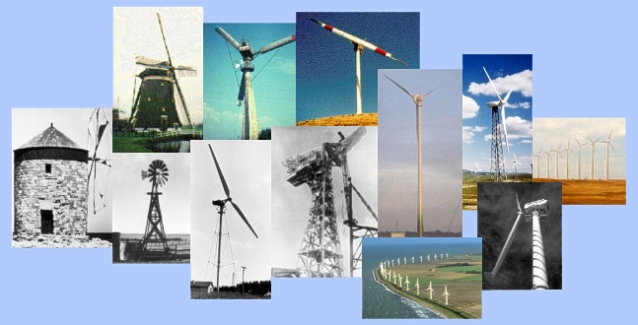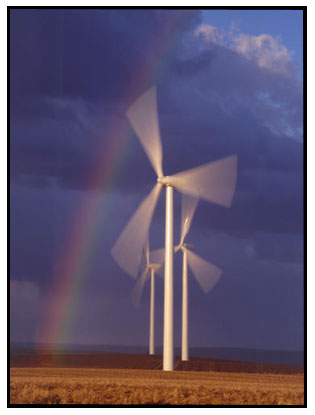|
|

http://www.telosnet.com/wind/
The use of wind as a form of energy has had a rich and long history.
Wind energy has propelled boats as early as 5000 B.C. By 200 B.C. simple
windmills were being used in China to pump water and in Persia to grind
grain.
By the eleventh century, people in the Middle East were using windmills
extensively for food production. This idea was carried back to Europe
by the returning crusaders and merchants. The familiar "Dutch Windmill"
rose to prominence in 1100 sparking a golden age for windmills. Its
design is believed to have originated in England being based upon the
ones seen in the Middle East. before spreading throughout Europe. Between
the 12th and 19th century, tens of thousands of windmills were constructed.
Most of these windmills were of similar design having rotor diameters
of up to 30 meters and shaft power between five and 30 kilowatts. Several
windmills were even constructed in New England during colonial times.
The advent of steam power and gasoline and electric motors were the
cause for the downfall of this wind power era.
The second coming of wind power can be seen today through the use of
large wind turbines and wind machines to generate electric power. In
Vermont in 1939, the first commercial wind turbine was constructed.
The Smith-Putnam wind turbine had a rotor dimension of 53 meters and
full power rating of 1.25 megawatts electric. Unfortunately the turbine
was only online between 1941-1945 due to cheaper alternatives to fuel.
The oil crisis of 1973 sparked interest in wind power as an alternative
form of energy. This revival lasted for approximately 20 years, due
largely to tax credits and limited interest until 1996 when Kenetech
(the major supplier of wind power in the US) declared bankruptcy.
Today's research into global warming has once again sparked the interest
in wind power this time due to it being a form of clean and renewable
energy. The increased concern over raising CO2 levels in the atmosphere
has caused many countries to look at alternative renewable forms of
nonpolluting energy with wind and solar power being at the heart of
those investigated. The leaders in this wind market today are Denmark,
Germany, and India.
Part I: The Historical Era
Dates |
Events of Note |
1
|
Hero (a.k.a Heron) of Alexandria uses a wind machine to power
an organ. |
~ 400 |
Reference to wind-driven Buddhist prayer wheels |
644, 915 |
References to pre-existing vertical axis windmills (panemones)
in Persia |
1137, 1272 |
References to pre-existing horizontal axis windmills in England
and Holland, respectively. |
~ 1400 |
Smock (rotatable cap) mills originating in Holland supercede post
mills (which turn on a vertical shaft). |
1200-1850 |
Golden age of windmills in western Europe, totaling perhaps 10,000
in England, 18,000 in Germany, 9,000 in Holland, and 50,000 overall. |
1850s |
Multi blade wind turbines for water pumping made and marketed
in the US. |
1769 |
James Watt granted a patent on his much-improved version of a
steam engine. |
1877, 1893 |
Invention of the 4-stroke gasoline and the diesel internal combustion
engines by Nikolaus Otto and Rudolf Diesel, respectively. |
1882 |
Thomas A. Edison commissions the first commercial electric generation
stations in New York City and London. |
1900 |
Competition from alternative energy sources reduces windmill population
to fewer than 10,000. |
1919, 1937 |
End of commercial operation of the last of the conventional old-style
mills in Long Island (New York) and Denmark. |
1850-1930 |
Heyday of the small multi blade wind machine in the US Midwest
- as many as six million units installed. |
1936+ |
US Rural Electrification Administration extends the grid to most
formerly isolated rural sites, which rapidly displaces wind machine
use. |
Part II: The Modern (Electric) Era
Dates
|
Events of Note |
| 1890-1893 |
LaCour in Denmark and Lewis Electric in New York state build wind
machines to generate electricity |
1933 |
Krasnovsky builds a 100 kWe wind machine in the Russian Crimea,
near Yalta |
1941-1945 |
The Smith-Putnam 1250 kWe wind turbine is installed and operated
on Grandpa's Knob, Vermont |
1973 |
The oil energy crisis inspires new interest in alternative energy
sources |
1974-1980 |
US Federal large Wind Turbine Program |
1976 |
US Energy Research and Development Administration (ERDA) small
wind machine development program |
1978 |
Public Utility Regulatory Policy Act (PURPA) requires that utilities
purchase electricity from small producers at the utilities' "avoided
cost" |
1981-1993 |
Wind turbine boom times in California: more than 12,000 units
installed, totaling some 1800 MWe |
1982-1994 |
Record rating 4 MWe Hamilton Standard 4TS-4 unit operating in
Wyoming |
1985, 1986 |
US federal and California tax credits for wind projects expire,
respectively |
1988 |
Worldwide large wind turbine sales, R&D expenditures, market
incentives bottom out due to decline in US |
1991 |
First commercial offshore wind farm, Vindeby, Denmark |
1992 |
National Energy Policy Act (NEPA) gives $0.015/KWhr production
tax credit for wind-generated electricity |
1996 |
Kenetech Windpower (US Windpower), largest US and world manufacturer,
declares bankruptcy. [assets sold to Enron Wind, then acquired by
GE Wind] |
1990-2000 |
Megawattage of installations in Europe grows at ~20%/year |
1998-1999 |
European manufacturers open wind turbine factories in US and China |
2001 |
US Department of Energy (DOE) announces goal and program to have
$0.03/KWehr electricity from wind by 2012. |
Table taken from: "Sustainable Energy: choosing
among options" pages 615-616 MIT Press 2005
|

